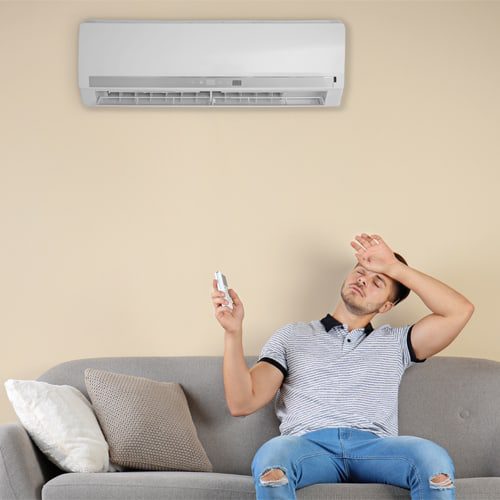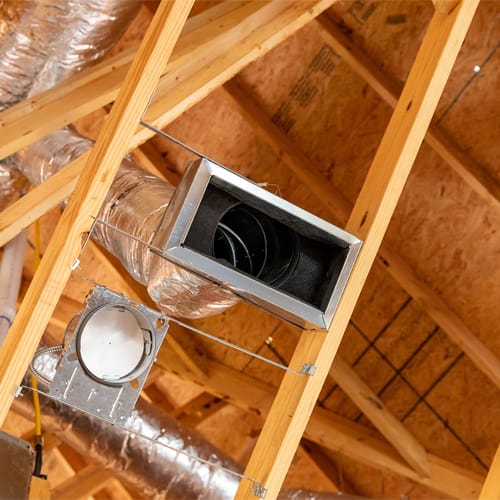Why is it so hot upstairs?
Have you noticed that a lot of people complain about their upstairs being too hot, or the downstairs being too cold? The temperature in most two-story homes can be as much as 10 degrees higher on the upper floor. Although a natural consequence of physics, it can make your home uncomfortable and inefficient.
But why is it so hot upstairs? There could be many reasons, but most homes will have a slight temperature difference simply because heat rises. Air (like any gas) expands as it is heated, causing it to disperse. Because the heated air is less dense than colder air, it buoys the hot air upward, much in the same way wood floats on the denser ocean.

But, the natural behavior of hot air isn’t the only reason there could be a difference between floors. A dramatic difference in temperature between stories is usually an indicator of an issue that should be addressed for efficient cooling. That doesn’t necessarily mean that there is a problem with your HVAC system. Insulation and other factors could be to blame.
Here we outline some of the potential problems why the second floor of a house is usually hotter than the first floor. If it seems the air conditioning just isn’t making it upstairs, contact us for a no-cost estimate. Our experts can determine if your HVAC could be the issue, and if so how we might resolve it.
Causes of large temperature differences between levels
As we mentioned, some temperature difference is to be expected in most two-story homes. When the temperature difference is slight, it might not be hot enough to warrant the expense of inspections, service or upgrades, but still be uncomfortable. In that case, you might be able to remedy the problem simply by:
- Checking and/or changing the filter in your HVAC unit. If it is dirty it can restrict air flow to other parts of the house.
- Switching the fan setting on your AC from “auto” to “on.” The circulating air will make you feel cooler, and you won’t really be using any more energy because the unit won’t have to cycle as often.
- Sealing off windows and entry points to the living areas of the second floor (including attic access). This prevents your cool air from escaping.
This is a good place to start, because if these eco-conscious measures fix the problem, you will have saved yourself quite a bit of time and money. Even if you do require experts to fix the problem, these measures will help you keep things as cool as possible as you wait to schedule.
If the above steps do not remedy the problem and your second story is still significantly hotter than the downstairs, you could need to take additional measures, including calling in a professional.
Below are more reasons the upstairs could be hotter than the downstairs.
Room factors
Do you find yourself asking, “Why is my bedroom hotter than the rest of the house?” It is likely that factors specific to the room are to blame. Size and number of windows, as well as how much sunlight streams through them each day, are a larger source of heat than you might think. Luckily, there are a few things that can help you cool things off a bit.
- Install good blinds, blackout curtains, or heavy drapes, and keep them closed when the sun is on that side of the house.
- Seal your windows with new caulking. Your cool air could be escaping through cracks you don’t even know exist.
- Contact a window professional if it seems as though the window itself is failing or incorrectly insulated.
- Cover any gaps not remedied by caulking with window covering kits.
Furthermore, the further away a room is from the thermostat, the less efficiently it will be cooled. Giving the room its own thermostat through a zone system could cool things off considerably without the purchase and costly operation of a window unit.
Poor insulation and/or ventilation
The number one reason why it is hot upstairs, cold downstairs is that the attic is poorly insulated or ventilated. It might seem counterproductive to add insulation for warmth and then circulate cold air through it, but the combination actually works together in a very important way.
As the Department of Energy explains, “In the summer, natural air flow in a well-vented attic moves super-heated air out of the attic, protecting roof shingles and removing moisture. The insulation will resist heat transfer into the house.” The experts go on to say that the biggest mistake homeowners make is to block the soffit and rafter vents, which makes appropriate air flow through the attic impossible. When there is no flow of air to whisk away the super-hot air of the attic, the insulation only serves to hold heat in the house, making the top floor the most uncomfortable.
While it is possible to DIY attic insulation, it is a job best left to professionals for the most efficient energy bills and effective cooling for the second story of a home.
Problems with ductwork for the HVAC system
The ductwork in your home is a very important part of your HVAC system. If the ducts are not sealed properly and offer appropriate air flow, it can cause problems with delivery of cooled air to the upper floor. You can lose up to 20% of the conditioned air from poorly sealed air ducts before it ever reaches the upper floor. Ductwork can become old and joints can break, so if you have an older system this could be a real possibility.
On the other hand, it is possible that your home never had the right ductwork for your home. If the ductwork installed was not the appropriate size, or if it was not insulated and sealed correctly, it would not be efficient at sending cooled air to the second story. Unfortunately, one-size-fits-all solutions sold to builders often include the wrong ductwork for the job.
If we determine that the ductwork is old, broken, or installed incorrectly, it is likely that you will need new ductwork installed. Decades of experience means that we’ve seen it all, and we’ll know pretty quickly if the ductwork is to blame. If we do the new ductwork installation, we’ll get the job done right the first time, and fast enough to get you back to your daily life.

Inappropriate HVAC system for the home’s demand
There are some home features, such as the high ceilings that are currently trending, that can affect the demand being placed on the unit. The more open a home’s floor plan, the harder the system has to work.
For two-story homes with open floor plans and high ceilings, a climate zone control system might be the best option. The Department of Energy estimates that most homeowners can save up to 30% on their energy bills simply by cooling their home in zones as needed. This requires installing a new, upgraded thermostat in each “zone” that you set, as well as the installation of damper motors and zone boards. Zones can be rooms, open areas, or whole floors.
Efficient zoning control for some homes may require two units, one for each floor. With such a system, you’ll be able to heat and cool each floor independently. When combined with programmable thermostats, you can set it and forget it, enjoying comfort throughout your home.
How to fix uneven heating and cooling in a 2-story home
Before you can even out the temperature between the first and second stories, you have to figure out exactly what is causing the problem. If you have significant temperature differences between levels and an older home, it is possible that you may need more than one solution to completely cool off your second floor for good.
Head up to the attic.
Your first step in troubleshooting is to visually inspect your attic. The Insulation Institute claims that up to 90% of American homes do not have adequate insulation, and it is the most common reason that the upstairs will be hotter than the downstairs.
You should be able to clearly see whether or not your attic is properly insulated. The Department of Energy recommends 13 to 18 inches of insulation in an attic, which means you should not be able to see any of the joists.
While you’re up there, make sure that none of the roof, eaves, soffit, or rafter vents are blocked. If they are, your attic isn’t properly ventilated either. Even adding an attic fan won’t help if those vents are blocked.
If you determine that your attic insulation and ventilation does need some attention, contact a trusted roofing contractor or insulation specialist to assist you.
Consider the age of your system.
Your air conditioner, ducts, and thermostats all have a lifespan. If your HVAC unit is more than ten years old, you should consider replacing it with a more energy efficient model, even though it might last longer. There is some variance in how long a thermostat will last, but it’s a good idea to replace it when you upgrade your system. The lifespan of ductwork can also vary, so it is a good idea to have your HVAC company inspect it often, especially if you plan on upgrading your unit.
Have your ductwork inspected.
If your air conditioner seems to be working extra hard to cool the rooms furthest away from the unit, it could be that your ductwork isn’t allowing the cooled air to be pushed into the rooms as it should. This could be due to leaks, breaks, dents, or simply the wrong ducts being installed in the first place.
Parts of your ducts may be visible to you from different access points around your home. Where you can, visually inspect the ducts for any signs of damage or failure. If you see anything suspicious, contact a professional to do a more complete inspection.
One of the most obvious signs that you have a ductwork issue is noise. When your air conditioner starts pushing air through the ducts and they start to rattle, it is likely that you don’t have the right ductwork for your home, or its joints have become damaged. You’ll need an experienced HVAC contractor to install the appropriate system for your HVAC.
Get a complete HVAC inspection and estimate.
If you need help figuring out how to get air conditioning to the second floor, our experts will be able to help you find solutions. After eliminating an insulation or ventilation problem, contact us to schedule a complete evaluation of the efficiency of your current system to discover if maintenance, repair, or upgrades might be necessary to correct the problem.

5636 Bush River Rd.
Columbia, SC 29212
SC License – #M104545
NC License – #32356
Phone: (803) 794-5526

